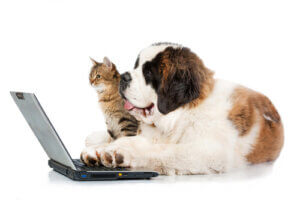Excessive Humanization and Social Networks: Risks for Your Pet


Written and verified by the lawyer Francisco María García
Among the many phenomena of the internet, we find the success of pets on social networks. In recent years, profiles dedicated to the pets of celebrities and anonymous people all over the world have multiplied. Even though the photos are really charming, are we aware of the risks of social networks? Today, we want to talk about how social networks can lead to excessive humanization. Keep reading.
Pets and social networks: An effervescent combination
It all started when some owners posted a few funny pictures of their pets on the older social networks. As you can easily imagine, these images aroused enormous interest and affection from users.
As a result, the pets became so popular that they earned their own profiles. And, with the advent of networks dedicated exclusively to photos and videos, pet accounts continued to grow. Despite being managed by the owners, all the information, photos, and design of the profiles were dedicated to our faithful companions.
But the story of pets with social networks doesn’t end there… The success was so great that the first exclusive social networks for pets began to emerge. Today, online relationship platforms for pets are trending all over the world.

What are social networks for pets all about?
The proposition is simple and very similar to that of social networks for people. These online platforms have been designed to enhance the social life of our pets. But they can also be used to promote adoption and reproductive control campaigns, in addition to helping in the recovery of lost animals.
Among them, we can find Animal Social Network and Dogster. Their platforms allow the sharing of photos, videos, events, campaigns, and all kinds of relevant news about the animal world. There are also chats and forums among users to exchange curiosities, information, and mutual help.
As is often the case on the web, the impact of these sites will depend on the use that will be made of it by users. On the one hand, social networks for pets can help disseminate information and raise awareness about responsible pet ownership. But we must also be aware of the potential risks of social networks for pets.
Recognizing the risks of social media
Experts warn about the negative and counterproductive impact of social networking on our social life. If we look at our day-to-day lives, we probably notice that we look at our phones more than at one another.
Many of us talk every day through chats or posts with friends and family; the consequence of these cyber-relationships is that we forget the real deal. It’s safe to say that social networks can alienate us as much as they bring us closer together.
If we let children and adolescents use social networks, we must be vigilant about online bullying. Unfortunately, many dangerous individuals use this means of communication to contact and persuade minors.
In the same way, it’s important to be aware of the risks of cyberbullying. Online humiliation and blackmail are another face of the traditional psychological and emotional harassment suffered by thousands of young people. Through social networks, teenagers can receive threats, pressure, or have to face the dissemination of false information.
Therefore, before allowing our young people to access these networks, it’s essential that we raise awareness of their risks. As parents, teachers, relatives, or friends, we must be sensitive about educating and clarifying doubts. In addition, we shouldn’t be ashamed to seek professional help if we observe changes in their behavior or symptoms of depression.

Social networks for pets: The danger of excessive humanization
If we want to focus on the risks of social networks for pets, we must talk about the dangerous phenomenon of excessive humanization. Many times, we see pet owners confusing the necessary care of their pets with treating them as human beings.
Each species has its own world and, within this world, they have their own needs and nature. If we treat a dog or a cat as if they were babies, then we fail to respect their unique characteristics and specific needs.
Each animal is a unique and singular being and should be respected in its similarities and differences to us. Our pets don’t need to relate through social networks, and their social life should be full of our presence, real affection, daily walks, games, and toys that stimulate their cognitive and emotional abilities.
Among the many phenomena of the internet, we find the success of pets on social networks. In recent years, profiles dedicated to the pets of celebrities and anonymous people all over the world have multiplied. Even though the photos are really charming, are we aware of the risks of social networks? Today, we want to talk about how social networks can lead to excessive humanization. Keep reading.
Pets and social networks: An effervescent combination
It all started when some owners posted a few funny pictures of their pets on the older social networks. As you can easily imagine, these images aroused enormous interest and affection from users.
As a result, the pets became so popular that they earned their own profiles. And, with the advent of networks dedicated exclusively to photos and videos, pet accounts continued to grow. Despite being managed by the owners, all the information, photos, and design of the profiles were dedicated to our faithful companions.
But the story of pets with social networks doesn’t end there… The success was so great that the first exclusive social networks for pets began to emerge. Today, online relationship platforms for pets are trending all over the world.

What are social networks for pets all about?
The proposition is simple and very similar to that of social networks for people. These online platforms have been designed to enhance the social life of our pets. But they can also be used to promote adoption and reproductive control campaigns, in addition to helping in the recovery of lost animals.
Among them, we can find Animal Social Network and Dogster. Their platforms allow the sharing of photos, videos, events, campaigns, and all kinds of relevant news about the animal world. There are also chats and forums among users to exchange curiosities, information, and mutual help.
As is often the case on the web, the impact of these sites will depend on the use that will be made of it by users. On the one hand, social networks for pets can help disseminate information and raise awareness about responsible pet ownership. But we must also be aware of the potential risks of social networks for pets.
Recognizing the risks of social media
Experts warn about the negative and counterproductive impact of social networking on our social life. If we look at our day-to-day lives, we probably notice that we look at our phones more than at one another.
Many of us talk every day through chats or posts with friends and family; the consequence of these cyber-relationships is that we forget the real deal. It’s safe to say that social networks can alienate us as much as they bring us closer together.
If we let children and adolescents use social networks, we must be vigilant about online bullying. Unfortunately, many dangerous individuals use this means of communication to contact and persuade minors.
In the same way, it’s important to be aware of the risks of cyberbullying. Online humiliation and blackmail are another face of the traditional psychological and emotional harassment suffered by thousands of young people. Through social networks, teenagers can receive threats, pressure, or have to face the dissemination of false information.
Therefore, before allowing our young people to access these networks, it’s essential that we raise awareness of their risks. As parents, teachers, relatives, or friends, we must be sensitive about educating and clarifying doubts. In addition, we shouldn’t be ashamed to seek professional help if we observe changes in their behavior or symptoms of depression.

Social networks for pets: The danger of excessive humanization
If we want to focus on the risks of social networks for pets, we must talk about the dangerous phenomenon of excessive humanization. Many times, we see pet owners confusing the necessary care of their pets with treating them as human beings.
Each species has its own world and, within this world, they have their own needs and nature. If we treat a dog or a cat as if they were babies, then we fail to respect their unique characteristics and specific needs.
Each animal is a unique and singular being and should be respected in its similarities and differences to us. Our pets don’t need to relate through social networks, and their social life should be full of our presence, real affection, daily walks, games, and toys that stimulate their cognitive and emotional abilities.
This text is provided for informational purposes only and does not replace consultation with a professional. If in doubt, consult your specialist.








